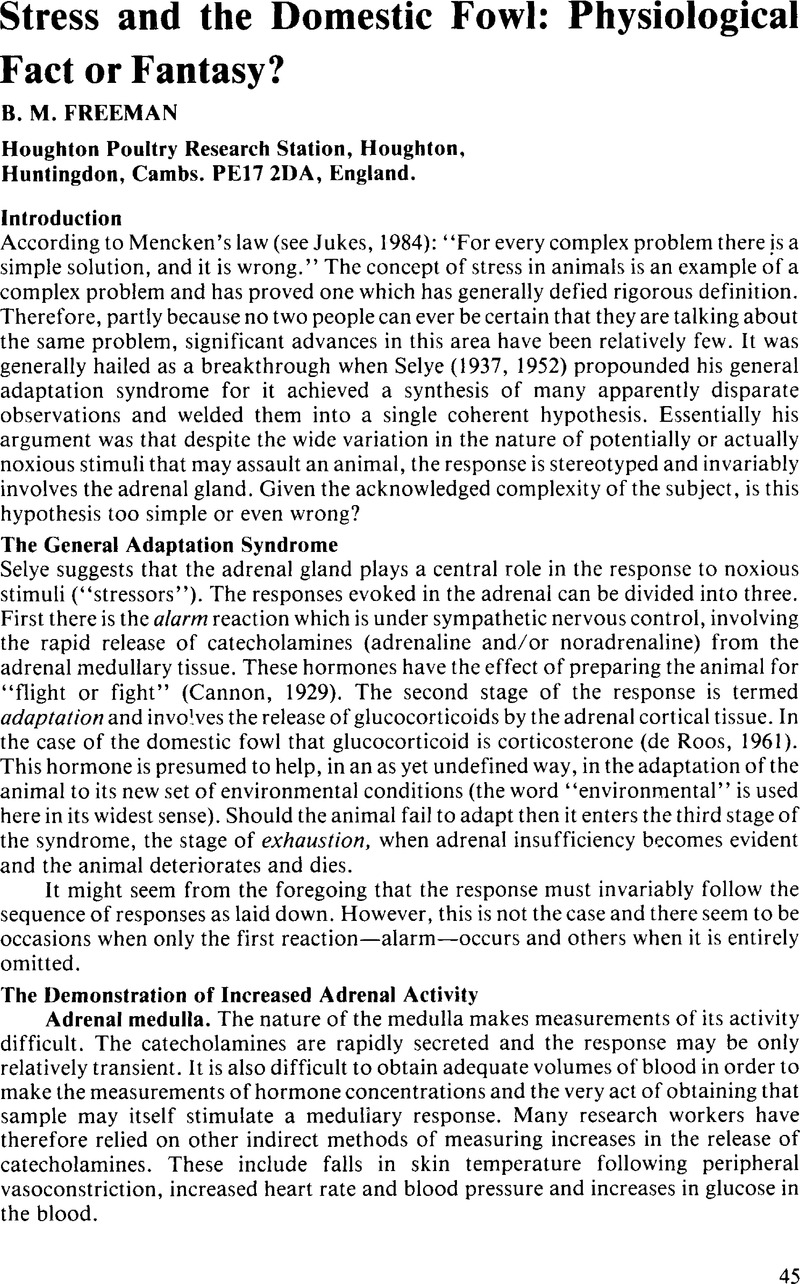Crossref Citations
This article has been cited by the following publications. This list is generated based on data provided by Crossref.
Hughes, B. O.
Gilbert, A. B.
and
Brown, Margretta F.
1986.
Categorisation and causes of abnormal egg shells: Relationship with stress.
British Poultry Science,
Vol. 27,
Issue. 2,
p.
325.
RUSHEN, J.
1986.
Some problems with the physiological concept of “stress”.
Australian Veterinary Journal,
Vol. 63,
Issue. 11,
p.
359.
Karunajeewa, H.
1987.
A review of current poultry feeding systems and their potential acceptability to animal welfarists.
World's Poultry Science Journal,
Vol. 43,
Issue. 1,
p.
20.
Siegel, P. B.
Gross, W. B.
and
Dunnington, E. A.
1989.
Effects of dietary corticosterone in young leghorn and meat‐type cockerels.
British Poultry Science,
Vol. 30,
Issue. 1,
p.
185.
Cashman, P. J.
Nicol, Christine J.
and
Jones, R. B.
1989.
Effects of transportation on the tonic immobility fear reactions of broilers.
British Poultry Science,
Vol. 30,
Issue. 2,
p.
211.
Beuving, G.
Jones, R. B.
and
Blokhuis, H. J.
1989.
Adrenocortical and heterophil/lymphocyte responses to challenge in hens showing short or long tonic immobility reactions.
British Poultry Science,
Vol. 30,
Issue. 1,
p.
175.
GRAY, H.G.
PARADIS, T.J.
and
CHANG, P.W.
1989.
Research Note: Physiological Effects of Adrenocorticotropic Hormone and Hydrocortisone in Laying Hens.
Poultry Science,
Vol. 68,
Issue. 12,
p.
1710.
Jones, R.Bryan
1989.
Chronic stressors, tonic immobility and leucocytic responses in the domestic fowl.
Physiology & Behavior,
Vol. 46,
Issue. 3,
p.
439.
Maxwell, M. H.
1993.
Avian blood leucocyte responses to stress.
World's Poultry Science Journal,
Vol. 49,
Issue. 1,
p.
34.
Zulkifli, I.
and
Siegel, P.B.
1995.
Is there a positive side to stress?.
World's Poultry Science Journal,
Vol. 51,
Issue. 1,
p.
63.
Hocking, P. M.
Maxwell, M. H.
and
Mitchell, M. A.
1996.
Relationships between the degree of food restriction and welfare indices in broiler breeder females.
British Poultry Science,
Vol. 37,
Issue. 2,
p.
263.
Hofer, Heribert
and
East, Marion L.
1998.
Stress and Behavior.
Vol. 27,
Issue. ,
p.
405.
Laseinde, E. A.O.
and
Olatunde, I. A.
1998.
Observations on the Growth Performance of Broiler Starters and Finishers Exposed to a 24-Hour Feed and Water Withdrawal.
Journal of Applied Animal Research,
Vol. 14,
Issue. 1,
p.
87.
Dawkins, Marian Stamp
1999.
The role of behaviour in the assessment of poultry welfare.
World's Poultry Science Journal,
Vol. 55,
Issue. 3,
p.
295.
Hocking, P.M.
Maxwell, M.H.
Robertson, G.W.
and
Mitchell, M.A.
2001.
Welfare assessment of modified rearing programmes for broiler breeders.
British Poultry Science,
Vol. 42,
Issue. 4,
p.
424.
Hocking, P.M.
Maxwell, M.H.
Robertson, G.W.
and
Mitchell, M.A.
2002.
Welfare assessment of broiler breeders that are food restricted after peak rate of lay.
British Poultry Science,
Vol. 43,
Issue. 1,
p.
5.
Rivera, E.
Benjamin, S.
Nielsen, B.
Shelle, J.
and
Zanella, A.J.
2002.
Behavioral and physiological responses of horses to initial training: the comparison between pastured versus stalled horses.
Applied Animal Behaviour Science,
Vol. 78,
Issue. 2-4,
p.
235.
KHALIL, Ashraf M.
MATSUI, Kanji
and
TAKEDA, Ken‐ichi
2004.
Influence of sudden changes in management program on physiological and behavioral parameters in hens.
Animal Science Journal,
Vol. 75,
Issue. 3,
p.
253.
Dozier, W.A.
Thaxton, J.P.
Purswell, J.L.
Olanrewaju, H.A.
Branton, S.L.
and
Roush, WB
2006.
Stocking Density Effects on Male Broilers Grown to 1.8 Kilograms of Body Weight.
Poultry Science,
Vol. 85,
Issue. 2,
p.
344.
Wall, Julian P.
and
Cockrem, John F.
2009.
Effects of corticosterone treatment on responses to fasting in Japanese quail.
Comparative Biochemistry and Physiology Part A: Molecular & Integrative Physiology,
Vol. 154,
Issue. 2,
p.
211.





